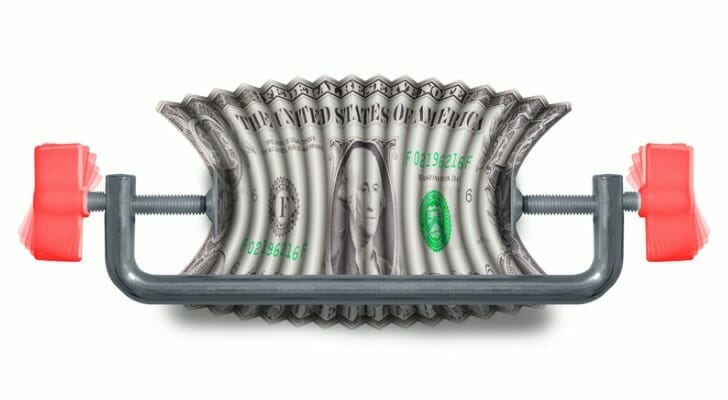When stock prices experience rapid shifts, the conditions may be ripe for a squeeze. In this scenario, investors may find themselves buying or selling shares of stock outside their normal trading pattern in order to minimize losses. A gamma squeeze is an extreme example of this, in which investor buying activity forces a stock’s price up – often quite sharply. That’s what happened in early June 2021 as shares of AMC experienced dramatic, sudden gains. Gamma squeezes are often associated with options trading and they can be problematic for investors who don’t fully understand how they work. A financial advisor can provide advice on various investing strategies and your portfolio.
Understanding a Gamma Squeeze
As mentioned, a squeeze can happen when stock prices unexpectedly come under pressure. Investors who own the stock may feel “squeezed” by rapidly changing prices and as a result, they change their positions in the stock.
A short squeeze is a specific type of stock squeeze. With a short squeeze, an increase in stock prices can force people who shorted the stock to buy back their shares. Shorting means investors are betting that the price of a stock will go down, rather than increase. A short squeeze can end up driving stock prices up, sometimes significantly, though this upward shift in pricing may not be sustainable for the long term.
A gamma squeeze can happen when there’s widespread buying activity of short-dated call options for a particular stock. This can effectively create an upward spiral in which call buying triggers higher stock prices, which results in more call buying and even higher stock prices.
How the Options Market Works
At its core, the options market allows investors to buy or sell the right, but not the obligation, to purchase or sell an underlying asset at a predetermined price within a specified time frame. This flexibility makes options a powerful tool for hedging against potential losses or speculating on future price movements. Unlike stocks, which represent ownership in a company, options are derivatives, meaning their value is derived from the performance of an underlying asset, such as a stock, index or commodity.
Gamma is a crucial concept in options trading, representing the rate of change in an option’s delta relative to the price movement of the underlying asset. Delta measures how much an option’s price is expected to move per $1 change in the underlying asset’s price. Gamma, therefore, indicates how much the delta will change as the asset’s price fluctuates. High gamma values suggest that an option’s delta is highly sensitive to price changes, which can lead to significant shifts in the option’s value. Traders closely monitor gamma to manage risk and adjust their portfolios accordingly.
How a Gamma Squeeze Works
Certain conditions have to be met for a gamma squeeze to manifest in the market. It starts with investors making assumptions about a particular stock’s price. Specifically, they assume that the stock will rise in price.
This leads to buying short-dated call options in the stock on a large scale. A call option’s value increases when the underlying stock it’s associated with increases in value. Meanwhile, this puts the institutional investors selling the options in a short position.
If this pattern continues with investors sinking more money into call potions, that can force institutional investors to buy more shares of the stock. This is a necessary step for hedging against the short position they now find themselves in.
The gamma squeeze happens when the underlying stock’s price begins to go up very quickly within a short period of time. As more money flows into call options from investors, that forces more buying activity which can lead to higher stock prices. Investors who purchase call options and sell when stock prices are high can reap sizable profits but the institutional investors who had to cover their short positions might see significant losses.
What Causes a Gamma Squeeze?

Gamma squeezes can occur as the result of widespread speculation about where a stock’s price may be headed. For example, if a company is struggling financially then institutional investors may decide to short the stock in the belief that the price will fall. That isn’t out of the ordinary but what is unusual is when a group of investors or a single large institutional investor starts buying up stock, resulting in a short squeeze. For example, January 2021 saw an increase in short squeeze activity surrounding several companies, including GameStop Corp. (GME) and AMC Entertainment Holdings (AMC).
Over a relatively short period, GME experienced a sharp spike as retail investors coordinated to drive up the stock’s price. At one point, the stock’s price had increased by more than 400%. At the same time, several large hedge funds held short positions in the company, owing to negative assumptions about its long-term financial outlook.
As attention surrounding GME grew, the stock’s price continued to climb, attracting more investors. This put market makers in the position of having to buy additional shares, which meant more price increases. As the stock’s price continued its unprecedented rise, hedge funds that were short in the stock finally were forced to close out their positions, in some cases booking billions in losses.
What Gamma Squeezes Mean for Investors
A gamma squeeze could be an opportunity for investors but it can also be risky. Depending on what’s driving a short squeeze and the resulting gamma squeeze, they can last for days or weeks or peter out very quickly. For that reason, timing plays an important part in determining whether a gamma squeeze results in a profit or a loss for your investment portfolio.
Once a gamma squeeze reaches its peak, price reversals can happen very quickly and you may see a steep decline in stock prices. For this reason, trading options is something that may not be right for every investor unless you have a high tolerance for risk.
Options trading in general is riskier than trading stocks, mutual funds or ETFs simply because there’s a certain amount of guessing that goes on about what will happen with a stock’s price. Guess right and you could benefit from a sizable payoff. Guess wrong, on the other hand, and you may face steep losses.
Bottom Line

Gamma squeezes can create opportunities for investors when they happen but it’s important to keep the risks in mind. The GameStop gamma squeeze provides a great example of how much timing matters when attempting to take advantage of this kind of strategy. If you’re interested in options trading, then it helps to choose an online brokerage account that’s fee-friendly. Many online brokerages now offer $0 commission-fee options trading, with low per-contract fees.
Tips for Investing
- Consider talking to a financial advisor about the pros and cons of options and how to spot a gamma squeeze in the making. Finding a financial advisor doesn’t have to be hard. SmartAsset’s free tool matches you with up to three vetted financial advisors who serve your area, and you can have a free introductory call with your advisor matches to decide which one you feel is right for you. If you’re ready to find an advisor who can help you achieve your financial goals, get started now.
- Whether you’re considering getting started with investing or you’re already a seasoned investor, an investment calculator can help you figure out how to meet your goals. It can show you how your initial investment, frequency of contributions and risk tolerance can all affect how your money grows.
Photo credit: ©iStock.com/fotopoly, ©iStock.com/JuSun, ©iStock.com/sefa ozel
